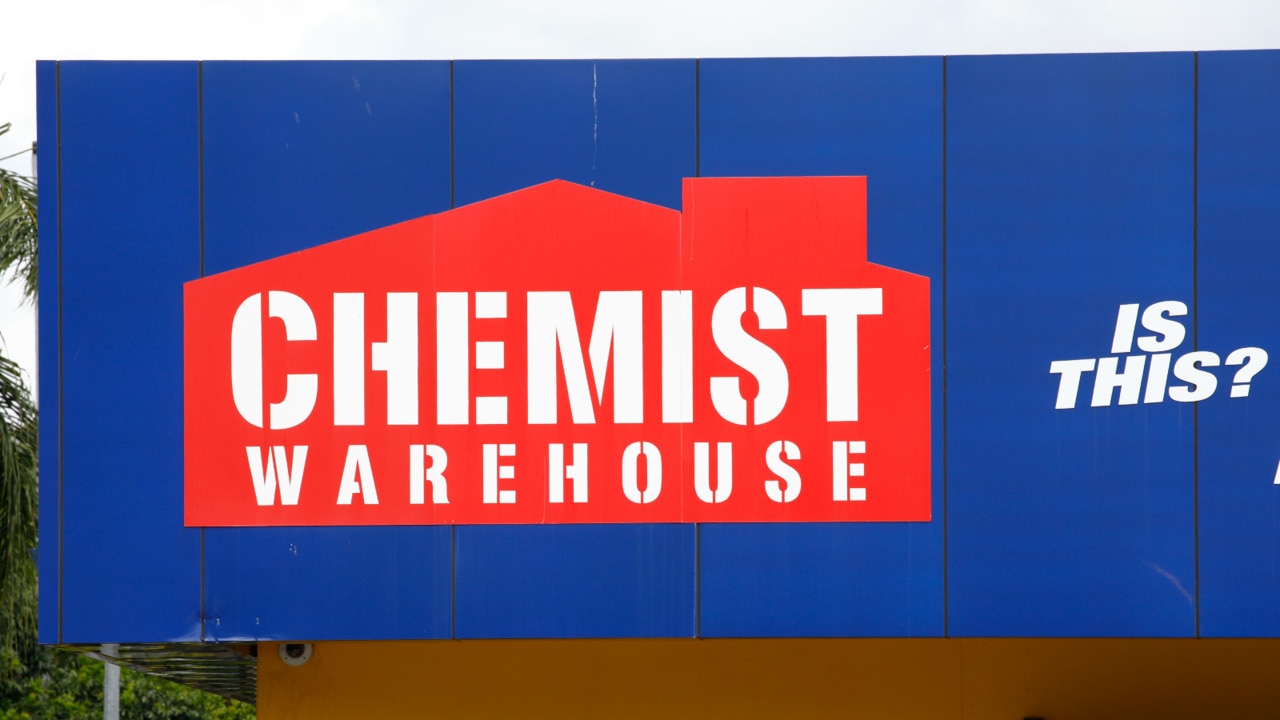Can Chemist Warehouse keep its animal spirits alive after an ASX debut?
Chemist Warehouse has plenty of ambition, although the restraints of a $9bn backdoor ASX listing may temper some of those plans.

Business
Don't miss out on the headlines from Business. Followed categories will be added to My News.
For many, the moment of the $9bn reverse listing of Chemist Warehouse offers the first insight into the secrets behind the deeply private retailer, including its stunning financial machinery and how it was able to up-end the healthcare market.
The listing also puts a spotlight on the ambition under private ownership, with the Chemist Warehouse founders – Jack Gance and Mario Verrocchi – laying out a 100-year plan to relentlessly build out a brand and all the scale that comes with it.
As the private owners take a leap of faith and take Chemist Warehouse public using a merger with chemist distributor Sigma Healthcare, the test will be whether the brash retailer can continue along the same path given all the investor scrutiny and near-term earnings pressures that come with being a listed company.

The new entity will also need to adjust to a new management team and, while the founders and their family will be closely involved, it will be in a new way. Investors need to know the listing marks the beginning of a different Chemist Warehouse from the industry upstart of recent decades.
After years of talk of an eventual stockmarket listing, Verrocchi says the merger with the listed-Sigma shouldn’t been seen as the endpoint for the company that can traced back 50 years.
“We had a (Chemist Warehouse) shareholders meeting last night and I ended it by saying, ‘just when you think everything’s finished, you realise it’s just the beginning’. And I think it’s a bit like that here,” Verrocchi says.
Retailing clout
From a single store in the working class suburb of Reservoir in Melbourne’s north, Chemist Warehouse has grown to be one of Australia’s most successful retail brands. Today it sits alongside hardware giant Bunnings and electrical goods play JB Hi-Fi in terms of retailing clout and being able to disrupt their chosen segment of the market.
Chemist Warehouse is a multibillion-dollar national brand – delivering billions of dollars in wealth to its founders – with more than 600 stores and franchise owners and international expansion into New Zealand (42 stores), China (six) and Ireland (six) and plans of more growth to come.
Last year it turned over almost $8bn in sales, including franchise members. The head company generated earnings last year of $460m, while posting profit margins of 15 per cent, excluding non-franchise sales, putting it among the best in class in the retailing business.
Bunnings delivers profit margins at 12 per cent while department store discounter Kmart generates about 7 per cent margins on a similar revenue base as Chemist Warehouse. Meanwhile, JB Hi-Fi last year recorded nearly $10bn in annual sales, and profit margins of 8.6 per cent.

At nearly $9bn, a debut of Chemist Warehouse on the ASX will become one of the top 60 companies on the ASX, putting it alongside TPG Telecom and Seek, and slightly under airline Qantas.
Verrocchi says the world’s best retailers have 100 years of brand behind them, and uses that template for Chemist Warehouse. Roughly 30 years in expanding in the local market; 30 to hit new markets (including offshore) and the next 30 to build out the franchise in the markets.
A big part of the Chemist Warehouse growth story comes down to the constant refining of its retailing model, and much of this has been the freedom to fail privately.
Indeed, in the early days of expansion of the Chemist Warehouse brand in the year 2000 both Verrocchi and Gance wanted to deliver a retailer that was built more like a supermarket, where scale counted and prices were highly competitive. They also recognised that chemists weren’t working the shopfront as hard as behind the counter. They steadily improved this equation, so that two-thirds of their store sales are now built around non-pharmacy sales. A standard chemist still does less than 30 per cent of sales front of house. Most importantly, the pair recognised the power of the distribution model in getting products to stores and franchise members, and this is the financial engine room of its operations.
Verrocchi says when he started in pharmacy 43 years ago, UK retailer Boots was the “gold standard”. What caught his attention was that Boots manufactured its own products, and it had distribution capabilities supporting a national store network. Unlike the chemist co-operatives that featured in the Australian market at the time, Boots controlled its own destiny.
What also worked for Boots was that it stripped out all repetitive costs and pooled resources, Verrocchi says. This delivered “affordable health outcomes” to more people in more locations.
Verrocchi admits that in the early days they didn’t always get it right and there was a steep learning curve about how to run a low-cost retailing model. Indeed, he likens the discounting to trying to eat soup with a fork. “You gotta go real hard at it,” he says.
But it was persistence that allowed them to get it right. “We adapted. We changed, we twisted, and we evolved the model and started to go in the right direction,” he says.
“Our confidence doesn’t come from being wrong. It comes from not fearing being wrong.”
Listing plan
The path for listing is being billed as a Sigma Healthcare buyout of Chemist Warehouse, although it’s more like Sigma catching a tiger by the tail.
The $8bn-plus Chemist Warehouse is effectively being folded in to the listed and much smaller drug distributor in an all-stock deal and $700m cash that goes to Chemist Warehouse shareholders, mostly made up of the Gance and Verrocchi families. The deal is being proposed by the way of a scheme of arrangement and, if all goes to plan, Chemist Warehouse investors will hold almost 86 per cent of the merged company, with the balance going to existing Sigma shareholders.
There’s still a long way to go in the planned deal. Indeed, regulatory issues could be a major stumbling block, with the competition regulator yet to assess the deal that will see the Chemist Warehouse brand alongside Sigma’s Amcal brand and Discount Drug Stores, taking the store footprint to more than 900, including franchise owners. Expected to come under most scrutiny is the distribution business, with Sigma providing the pharmaceutical supply chain for more than 1000 chemists (including Chemist Warehouse) stores. Chemist Warehouse’s distribution by comparison is built around non-drug products. While the Sigma board and its key private equity backer HMC Capital have endorsed the deal, Sigma shareholders will still need to vote on the merger. A $400m capital raising to help fund the deal will be the first big test of investor support.

Verrocchi acknowledges a “pure IPO” would have been a logical pathway for an ASX listing, although ironically he taken a private mindset to getting the job done.
The window for a merger with Sigma opened quickly as part of distribution talks, and Chemist Warehouse doing the work preparing for its own listing had meant it could move fast.
At the same time, Verrocchi saw the cost of listing – possibly running into the hundreds of millions – as a waste. A merger also delivers the prospect of $60m in annualised savings from the first year. A governance structure is already in place in Sigma along with an in-built shareholding that understands the pharmacy market.
Meanwhile, the new entity is likely to get instant access to the S&P/ASX 200 index, putting it on the radar of most fund managers.
“I think this deal is quick, effective, (and) offers compelling industrial logic. We also get access to those synergies which we wouldn’t have gotten in another place,” Verrocchi says.
To be sure, it’s going to be a different business experience and one that sees a shift in momentum as Chemist Warehouse adjusts to the Sigma business model.
So too is the make-up of the board. The new entity will be chaired by Sigma’s Michael Sammells and Sigma’s well-regarded CEO, Vikesh Ramsunder, will remain as CEO. Gance and Verrocchi will be executive directors. Damien Gance, currently chief commercial officer of Chemist Warehouse group, also becomes an executive director, as does Chemist Warehouse executive Danielle Di Pilla, who joins the board of the merged group.
Verrocchi says the moment is right for listing. He cites a well-known quote, often attributed to Roman philosopher Seneca, that says success can be found at the intersection of opportunity and preparation. “I think we’re living proof of that.”
johnstone@theaustralian.com.au
More Coverage
Originally published as Can Chemist Warehouse keep its animal spirits alive after an ASX debut?





